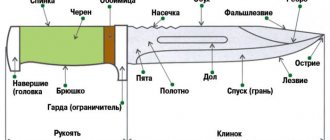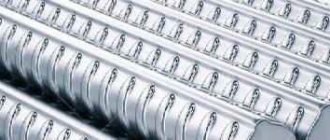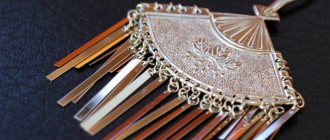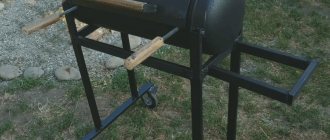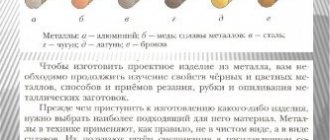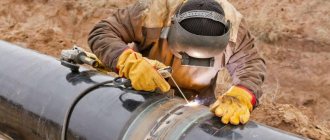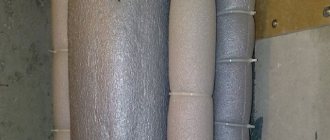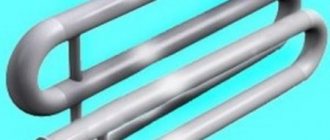How to distinguish stainless steel from aluminum?
Basic knowledge of chemistry and a little ingenuity will help you get the first information about the metal.
- Identifying differences using a magnet
The two materials in question are visually similar to each other. If, when attached to a magnet element, it does not stick, then it is definitely not aluminum (Al). The sample under study may be stainless steel, which has a negligible Ni content. If chromium or cuprum predominates in it, it will also not be magnetic and you will have to use a different technique.
- Recognition by marking
Many of the stainless products produced by domestic manufacturers contain information in the form of markings. The presence of the abbreviation “stainless steel” on them indicates that it is stainless steel and not aluminum.
- Definition using paper
The most budgetary and common method. To use it, you will need a clean, thick sheet of white paper. The technique is used for metal recognition at home. Before finding differences, it is necessary to clean the surface of the material from dirt, greasy oils and deposits. Next, using maximum pressure, you need to run a sheet of paper over the cleaned part of the metal. If it is stainless steel, there will be no traces left on the snow-white surface; if it is aluminum, gray spots will appear.
It is difficult to visually determine the material of manufacture, since the 2 metals are very similar to each other. If you take a closer look at the products, you will notice a barely visible shiny tint, indicating that this is stainless steel.
A product made of (Al) with a gray or whitish tint will have a matte surface, and after grinding, an oxide film will appear.
- Metal recognition by mechanical impact
To obtain the most accurate indicators, the technique should be used in the evening or at night. Hit the metal surface with a hard object. If it is stainless steel, a pronounced spark will appear; in an aluminum product, such an effect will not be observed.
- Determination using physicochemical indicators
The thermal conductivity of aluminum is much better than that of stainless steel. An example of this is the rapid heating of a liquid under identical conditions.
Thermal conductivity (Al) is 660 degrees, for stainless steel - 1800 degrees. When reaching 700 degrees, the aluminum product will melt first. It is impossible to melt the second product yourself, without the conditions of an industrial enterprise.
- Chemical recognition methods
How to distinguish 2 identical metals - sodium or potassium hydroxide will help. Treat the surface of the product with it. If after this the metal remains unchanged, then you are dealing with stainless steel. Otherwise, it is 100% aluminum. Treating the element with copper sulfate will also allow you to determine the type of metal. If it is stainless steel, there will be no traces of chemical exposure left on it.
You can also experiment with acid, which can even be lemon juice. The effect of acid on an aluminum surface will provoke its modification, which cannot happen with stainless steel.
Aluminum alloy 7075
State T6
Alloy 7075, an Al-Zn-Mg-Cu-Cr alloy, has the most widespread and long-lasting use of all the 7xxx series alloys. It was introduced in Japan in 1943, was a top secret and was used to make Japanese military aircraft. Alloy 7075 was originally used for thin cross-section parts and components, primarily in the form of sheets and extrusions. For these products, the hardening rate is usually very high and tensile stresses do not occur in the short transverse direction. Therefore, stress corrosion cracking is not a problem for such materials in the high strength T6 condition.
However, when alloy 7075 is used in large sized and thick products and parts, it becomes clear that such products and parts heat strengthened to T6 conditions often do not meet the specified requirements. Products that were produced by extensive machining from large forgings, extrusions or plates were then subjected to long-term tensile stresses in unfavorable orientations. Under such operational conditions, stress corrosion cracking (stress corrosion) occurred quite frequently.
Condition T73
The solution to this problem was the introduction of the T73 condition for thick and massive 7075 alloy products. The heat treatment used to obtain this condition requires a two-stage artificial aging. The second stage is performed at a higher temperature than that used to achieve the T6 state. This additional heat treatment reduces the strength to a level below that achieved by alloy 7075 in the T6 condition.
The T7 state is achieved by overaging, which means that the aging of the alloy continues after reaching the peak values of its hardness and strength, in contrast to the T6 state.
Numerous experiments and long-term operating experience have confirmed that alloy 7075-T73 has significantly higher resistance to stress corrosion compared to alloy 7075-T6.
Interestingly, the wheels of the famous Curiosity rover are made from 7075-T7351 alloy using a machined one-piece forged ring (Figure 8).
(a) Figure 8 – Wheel of the Curiosity rover made of aluminum alloy 7075-T7351: a - on Earth; b – under operating conditions on Mars
The most reliable method for metal recognition
Knowing the specific density of elements will help you quickly determine the type of material. For example, the density index (Al) is 2.6 g/cm3; for stainless steel it is 3 times higher. The technique is effective for products with large dimensions and weight (having the correct shape).
The essence of the technique is to determine the volume of the product and calculate its specific gravity. In such cases, you cannot do without knowledge of a special formula.
You can visually familiarize yourself with the methods of comparing metals from video sources posted on Internet resources. If you look closely at the photo, you can see the differences between two identical metals.
“AnexMetall” is a metal receiving facility that provides a range of services for the acceptance of ferrous and non-ferrous scrap metal, cable scrap, recycling, dismantling, etc.
Which bike frame should you choose?
About a dozen years ago, steel was the leading material used in bicycle frames. Almost all models were based on this hard and stable material. Along with the development of technology used in the industry, the material that forms the basis of the bicycle has also changed. Today, cyclists mainly choose between aluminum and carbon.
The frame is the base, the framework of the bicycle, on which all its elements are based. The geometry of the frame, as well as the material from which it is made, influence the nature of the product, the ride comfort and the capabilities that the bike gives us. The most commonly used material for bicycle frames is aluminum. This material is primarily characterized by high rigidity. This feature gives us the stability and reliability of the bike.
On the other hand, due to its lower elasticity, it has poorer vibration resistance. If we do a lot of cross-country riding, a more flexible plastic frame may be better for us.
Aluminum or stainless steel?
Hello, friends! I'm asking for advice on sapromat. I made a portable, collapsible antenna consisting of an ASh-4, to which 2 more aluminum elbows of 1.3 m each were added from the bottom. I am pleased with the design, but I would like to increase the strength a little in order to be able to lengthen and decorate it. Among those that are suitable in diameter, there is a stainless steel pipe for sale (the brand of metal is unknown) with a diameter of 14 mm and a wall thickness of 1 mm. What will be stronger than stainless steel 14 mm, wall thickness 1 mm, length no more than 3 m, or aluminum AD31 with a diameter of 20 and 16 mm, wall thickness 2 mm, length 2.5 m? How will stainless steel behave if you accidentally move it: will it bend or burst and falling pieces of the antenna can damage something?
Stainless steel, if that is what it is of course, is a soft and ductile metal and is not used for the manufacture of load-bearing structures.
I would use the AD31T - a telescope. There is one more point. An antenna or mast with a height of more than 7 m, no matter what it is made of, will “play”, which means it will not be possible to install it without guy wires. :crazy: If you want to make it look pretty, paint the horse in a checkerboard pattern - white/red or blue/white. or something else. Place a light bulb (red LEDs) on the top end - for aesthetics.
Aluminum alloys series 7xxx
The solubility of zinc in aluminum decreases from 31.6% at 275 ºС to 5.6% at 125 ºС (Figure 2). The 7xxx series industrial alloys contain zinc, magnesium and copper with minor additions of manganese and chromium, as well as zirconium to control grain growth and recrystallization.
Figure 2 - “Aluminum” section of the aluminum-zinc phase diagram [2]
Aluminum alloys of the 7xxx series are used for the manufacture of load-bearing elements of aircraft, such as the upper shells of wings, stringers, horizontal and vertical stabilizers. Horizontal and vertical stabilizers have the same design criteria as wings. The upper and lower surfaces of the horizontal stabilizer experience bending and compressive loading is critical for them. Therefore, the compressive modulus of elasticity is the most important property. Critical design parameters of upper wing components are compressive strength and fatigue resistance.
How to distinguish aluminum from stainless steel
| 31.10.2017 16:13 |
The material in question presents ten ways to distinguish aluminum from stainless steel. Some of them are very easy to use at home, without having absolutely any tools, equipment or chemicals. This will allow you to quickly and accurately determine the value of a particular item (product) made of aluminum or stainless steel.
Which frame to choose for your bike?
Steel frame, pros and cons
The following types are used to make steel frames:
- Ordinary steel.
- Carbon steel.
- Steel alloyed with chromium and molybdenum.
Standard quality steel. It has the lowest properties, so bicycles are of low cost. Such material quickly deteriorates, the frame rusts, and the bicycle becomes unusable.
Frames made of carbon steel have good strength properties and are also resistant to corrosion. They are quite flexible, so they smooth out all the bumps on the road. Such designs are ideal for normal driving, as well as for performing tricks. Carbon steel can withstand heavy loads, up to 150 kg.
Alloy steels make the structure more reliable, durable and lightweight. Most often, frame steels are alloyed with molybdenum and chromium. Molybdenum affects the structure of steel, making it fine-grained, thereby increasing strength. Chrome provides corrosion resistance.
The price for such a frame starts from $400. The high cost is the most significant drawback, which is why such bicycles are not in demand.
Advantages of steel frames:
- high levels of strength and rigidity;
- durable;
- withstand impacts;
- easy to maintain;
- Unlike aluminum frames, steel ones do not accumulate fatigue. This property allows the element not to break at one moment, so the cyclist can notice the crack in time and replace the damaged part;
- It is quite easy to repair steel structures; all that is required is welding;
- bicycles are inexpensive;
- physical properties make it possible to dampen vibrations during movement.
Disadvantages of a steel frame:
- tangible weight of the structure;
- structures made of ordinary steel quickly corrode;
- Due to the appearance of rust, it is necessary to carefully care for the bicycle: paint the surface, do not leave it in the rain and snow, and lubricate it regularly.
Aluminum frame, pros and cons
Most often, aluminum alloys are used to make frames. This material makes the structure lighter and more responsive to road imperfections, as well as being resistant to corrosion. Aluminum alloys are superior to steel in terms of rigidity, but they have lower density.
Advantages of an aluminum frame:
- light frame weight. Low-grade structures weigh about 2 kg, and high-quality ones up to 1.5 kg;
- good characteristics come with a low cost;
- the bike accelerates quickly on any terrain;
- do not corrode;
- support a lot of weight.
The disadvantages of this frame are directly opposite to the advantages of a steel frame:
- Despite rapid acceleration, they also rapidly lose inertia.
- Some models do not absorb vibrations from the road, so the ride can be painful.
- Fatigue accumulates, so a breakdown can occur at any time.
- Most breakdowns are almost impossible to repair.
Magnet
Unfortunately, it is not always possible to reliably distinguish these two metals from each other using a magnet. The fact is that any brand of aluminum, one way or another, does not stick to the magnet. But not all stainless steel has the same property.
If the product under study is magnetic, then it is definitely not aluminum. The sample may refer to stainless steels that contain sufficient amounts of nickel. If copper or chromium predominates in stainless steel, then it will not react in any way to a magnet.
Titanium frames
So we got to my favorite titanium. It is a bicycle on a titanium frame that represents for me maximum versatility, reliability and is my choice. Let me remind you that I have owned a bicycle based on the Titerra Ti-M19 frame for more than 12 years; some time ago I wrote about it in an article and talked about it in a video.
Titanium frames offer the weight of the best aluminum frames, the strength and comfort of chrome-moly frames, but are virtually corrosion-resistant and have fantastic durability. I note that the point about durability is valid if all technologies were followed during manufacturing. Otherwise, the frame may quickly break and repairing it will not be so easy, since the requirements for titanium processing conditions are very high, which directly affects the maintainability of the product, especially in the absence of the necessary conditions. But if the technology has been followed, then the titanium frame will serve you for decades, and it will also be enough for grandchildren and great-grandchildren.
In the manufacture of titanium frames, an alloy is used that contains other elements, not just titanium in its pure form. Such alloys are called Titanium alloys. For example, the most popular alloys used in the production of bicycle frames are 3AL-2.5V (3% Aluminum and 2.5% Vanadium) and 6AL-4V (6% Aluminum and 4% Vanadium). Often these alloys are combined and used in different parts of the same product. Other alloys are also used, for example, the well-known company Rapid uses aerospace alloy OT-4 and PT-7M in its frames.
As for the purpose of titanium frames, their range of application is very wide: year-round and daily use in the city, complex multi-day hikes, brevets, rides on any type of road, involving long walks, where you literally have to drag the bike on yourself. Except that I won’t include racing here, where high frame rigidity is important, allowing for maximum jerk and sharp control. Since titanium is soft, it has some losses when pedaling, especially when powered. Also, if a bicycle with a titanium frame is used by people weighing 100 kg or more, excessive softness may be noticeable, up to the feeling that the frame is simply dangling under you. Of course, this largely depends on the specific frame model.
Visually, a bicycle on a titanium frame looks completely discreet. Titanium is rarely painted, and if it is necessary to achieve a spectacular appearance, it is polished until it acquires a shine. Most frames are sold unpolished and for ordinary people they look like just gray pieces of iron. This can certainly be considered a plus. Despite their considerable cost, titanium bicycles attract much less attention than the decorated aluminum or fashionable carbon ones, which sometimes shout: “Hey, take me, I’m so cool!” I even know a case when, during a ride, a group stopped at a village store, leaned their bicycles and left. The titanium bicycle was the last one propped up. When people left the store, they found that the titanium (which was the very first) was lying to the side, but there was no trace of the new aluminum bike. Of course, you shouldn’t expect that this will always work and just leave your bike anywhere, but this is undoubtedly a plus.
The biggest disadvantage of titanium frames is their high price, which can be equivalent to or even higher than branded carbon products. So, for example, a used titanium frame, which is already 15 years old, can easily be sold for 20,000 rubles, but this cannot be said to be a very inflated price tag. Prices for new domestic titanium frames start from 45,000 rubles. Therefore, if you decide to assemble a bicycle on a titanium frame, then before that you need to weigh all the pros and cons and understand why all this is needed and whether the game is worth the candle. In many cases, a chrome-moly frame can be an excellent alternative to titanium for significantly less money.
When it comes to fashion and trends, titanium stands apart from frames made from other materials. In the circles of advanced cyclists it looks something like this: aluminum - mass-produced bicycles, unnoticeable and ordinary; carbon is for messengers and advanced cyclists; chrome-molybdenum - for connoisseurs of classics and old-school bicycles. The situation with titanium is special. Expressions like “classic” or “on trend” don’t work for him, he’s in a different parallel, out of time, and if you’ve achieved the zen of titanium bikes, you’re unlikely to be able to reconsider your views.
Plain paper
One of the easiest ways to determine the difference between aluminum and stainless steel. For the experiment you will need a sheet of plain paper. It must be white paper. The one used for printer printing is suitable. The denser it is, the better for the business.
The essence of the experiment is as follows. First, you need to clean the edge of the product under study from dirt, grease, oils and other deposits. Next, you need to move this place along a sheet of white paper. The pressing force should be as strong as possible. It is very easy to draw conclusions. Stainless steel on a white sheet will not leave any marks, while aluminum will show thin stripes of gray color.
Which bicycle frame is better, aluminum or steel?
In the modern world, a bicycle has become not only an element of sports life or a pleasant addition to active recreation; now more and more people use it as their main means of transportation . In the face of traffic jams, people began to choose bicycles to get to work faster. And even in our country with harsh winters, more and more people began to travel by bicycle at this time of year!
One of the most important parts in a bicycle is its frame. This is the base on which wheels and other attachments are mounted. The frame also acts as a damper between the rider and the wheels. The frame must withstand enormous loads . After all, it is constantly affected by the weight of the cyclist and uneven road surfaces. Therefore, the main criterion by which you should choose a bicycle frame is its strength. Strength directly depends on the material from which it is made. Let's consider the 2 most affordable materials: aluminum and steel. Which frame will be better?
Metal color
Another criterion that more or less clearly distinguishes stainless steel from aluminum is the shade of the product in question. If we have stainless steel in front of us, then its surface, as a rule, has a shiny, colorless tint. However, over time this condition persists.
If we consider an aluminum product, then the color of its surface is usually matte (this metal is difficult to polish to a glossy shine), gray or whitish. After processing with sandpaper, the sanded area will quickly become covered with an oxide film and become dull.
Comparative analysis of physical and mechanical properties of materials
| Material | Tensile strength, kg/mm2 | Thermal conductivity, W/(m x°C) | Linear expansion coefficient, 1/°С | TEMPERATURE. DEFORMATION AT t = 65 °C, mm/m | Melting point, °C |
| Stainless steel* | 55 | 40 | 10x10-6 | 0,65 | 1800 |
| Aluminium alloy | 18 | 221 | 25x10-6 | 1,62 | 640 |
*The properties of stainless steel and galvanized steel differ slightly.
Mechanical loads
This is also a fairly simple method that can be done at home. Its essence lies in the fact that the product under study must be hit against a solid metal object. To obtain a more accurate and visual result, this should be done in the dark.
If the product is made of stainless steel, then we will see quite pronounced sparking upon impact. It can be seen even in dim lighting. In the case of aluminum, there will be no sparking, even if you look very carefully in complete darkness.
Durability and environmental friendliness
Stainless steel for cookware is a strong alloy made mainly of nickel and chromium. Pots, cups, cauldrons and other utensils made from it last for a very long time without cracks, chips, deformations or scratches. In addition, the material is resistant to corrosion, does not oxidize and does not come into chemical contact with food.
If you compare stainless steel with other popular materials for cookware, it wins on all counts. The enamel is scratched, chipped, and covered with rust in cracked areas. Cast iron is comfortable to use, but the material itself is quite heavy and fragile. Well, the only advantages of aluminum are their low price and fast heating.
Thermal conductivity and melting
In the case of various containers, metal can be determined by heating. So, in an aluminum pan, ordinary water is brought to a boil quite quickly. Under the same conditions (volume of water, heating) in a stainless steel container, this process takes much longer. This is due to the fact that the thermal conductivity of aluminum is many times better than that of steel.
The melting point of aluminum is about 660°C, while for stainless steel this indicator is beyond 1800°C. When using a conventional gas burner, which is used as camping equipment, it is quite easy to reach a temperature of 700°C. This means that it is also possible to melt a small aluminum object on such a fire. Stainless steel cannot be melted under normal conditions (without pressurization and oxygen supply).
Fire properties of stainless steel and aluminum
The melting point of stainless steel is 1800 °C, and aluminum is 630/670 °C (depending on the alloy). The temperature during a fire on the inner surface of the tile (according to the test results of the Regional Certification Municipal Educational Institution) reaches 750 °C. Thus, when using aluminum structures, melting of the substructure and collapse of part of the facade (in the area of the window opening) may occur, and at a temperature of 800-900°C, aluminum itself supports combustion. Stainless steel does not melt in a fire, so it is most preferable for fire safety requirements. For example, in Moscow, during the construction of high-rise buildings, aluminum substructures are not allowed to be used at all.
Acid
For a successful experiment, a solution of citric acid or lemon juice will be sufficient. A more pronounced result will be obtained when the metal is exposed to more aggressive acids. The essence of the definition is the same as with vitriol and alkali. External processing will leave stains on the aluminum surface. Stainless steel does not react with acids.
Density
The longest and most difficult way to distinguish the two metals in question is to determine their specific density. This is only applicable for small products, as well as for those that have a regular geometric shape. The bottom line is that you first need to calculate the volume of the sample under study, and then, using a simple formula, find out its specific gravity.
The result obtained is ultimately compared with fixed density values. For aluminum this figure is about 2.6 g/cm3, while stainless steel is almost three times denser - from 7.6 to 8.1 g/cm3.
CITILOM company provides services for the reception and processing of scrap of various metals - both ferrous and non-ferrous.
What are we buying? Almost everything that clients no longer need.
The metal processing company CITILOM has been operating in the scrap metal trading market of St. Petersburg and the Leningrad region for about 10 years.
Copper in aluminum alloys 7xxx
The addition of copper to Al-Zn-Mg alloys along with small amounts of chromium and manganese gives these alloys the highest strength of any known aluminum alloy. Alloys of the quaternary system Al-Zn-Mg-Cu have the highest aging strengthening potential of all aluminum alloys: for some alloys, the tensile strength reaches 600 MPa, such as alloy V95, and even 700 MPa, like alloy V96. However, excessive increases in zinc and magnesium content reduce ductility and stress corrosion resistance. In these alloys, zinc and magnesium control the aging process, while the role of copper is to increase the rate of aging and increase sensitivity to quenching. Although copper reduces overall corrosion resistance, it increases resistance to stress corrosion.
Sources:
- Aluminum and Aluminum Alloys /JR Davis, ASM, 1993
- Trends in aluminum alloy development /R. Rajan at al - Rev. Adv. Mater. Sci. 44 (2016) 383-397
Source: aluminum-guide.ru
How to distinguish stainless steel from aluminum?
Basic knowledge of chemistry and a little ingenuity will help you get the first information about the metal.
- Identifying differences using a magnet
The two materials in question are visually similar to each other. If, when attached to a magnet element, it does not stick, then it is definitely not aluminum (Al). The sample under study may be stainless steel, which has a negligible Ni content. If chromium or cuprum predominates in it, it will also not be magnetic and you will have to use a different technique.
- Recognition by marking
Many of the stainless products produced by domestic manufacturers contain information in the form of markings. The presence of the abbreviation “stainless steel” on them indicates that it is stainless steel and not aluminum.
- Definition using paper
The most budgetary and common method. To use it, you will need a clean, thick sheet of white paper. The technique is used for metal recognition at home. Before finding differences, it is necessary to clean the surface of the material from dirt, greasy oils and deposits. Next, using maximum pressure, you need to run a sheet of paper over the cleaned part of the metal. If it is stainless steel, there will be no traces left on the snow-white surface; if it is aluminum, gray spots will appear.
It is difficult to visually determine the material of manufacture, since the 2 metals are very similar to each other. If you take a closer look at the products, you will notice a barely visible shiny tint, indicating that this is stainless steel.
A product made of (Al) with a gray or whitish tint will have a matte surface, and after grinding, an oxide film will appear.
- Metal recognition by mechanical impact
To obtain the most accurate indicators, the technique should be used in the evening or at night. Hit the metal surface with a hard object. If it is stainless steel, a pronounced spark will appear; in an aluminum product, such an effect will not be observed.
- Determination using physicochemical indicators
The thermal conductivity of aluminum is much better than that of stainless steel. An example of this is the rapid heating of a liquid under identical conditions.
Thermal conductivity (Al) is 660 degrees, for stainless steel - 1800 degrees. When reaching 700 degrees, the aluminum product will melt first. It is impossible to melt the second product yourself, without the conditions of an industrial enterprise.
- Chemical recognition methods
How to distinguish 2 identical metals - sodium or potassium hydroxide will help. Treat the surface of the product with it. If after this the metal remains unchanged, then you are dealing with stainless steel. Otherwise, it is 100% aluminum. Treating the element with copper sulfate will also allow you to determine the type of metal. If it is stainless steel, there will be no traces of chemical exposure left on it.
You can also experiment with acid, which can even be lemon juice. The effect of acid on an aluminum surface will provoke its modification, which cannot happen with stainless steel.
Steel frames
Want to touch a real classic? Buy a quality steel frame. For many decades, most bicycles were assembled on steel frames, ranging from children's Schoolchildren to professional-level Colnagos. In the early 90s, in professional cycling, steel frames were very quickly replaced by aluminum and then carbon ones. As for more budget bikes, steel is still in use here, and in very different ways.
The simplest and most budget-friendly ones are frames made of low-carbon steel, while the slightly more expensive ones are made of alloy steel (high tensile, hiten steel). The former are used on the lowest price range of bikes and are sometimes called bed or water tube frames. Indeed, their characteristics can hardly be called outstanding, especially the first ones. Such frames are heavy (4-5 kg) and are quite susceptible to corrosion. Nevertheless, they are inexpensive, strong and repairable, and dampen vibrations well.
The best and most interesting steel frames are made from chrome molybdenum steel (CrMo). The once legendary HVZ, Colnago, Bianchi, Pinarello and many other well-known manufacturers of road and mountain frames had in their arsenal many models of chrome-molybdenum frames of different levels, from average amateur ones to top professional ones, on which they won victories many times at iconic world cycling races, such as : Tour de France, Giro d'Italia, Paris-Roubaix and many others. Of course, today, in professional cycling, steel (even such high-quality steel) has not been used for many years, but many manufacturers continue to produce chrome-molybdenum frames, both road and mountain, which are very popular among classic connoisseurs and cyclists who value maximum performance. reliability, maintainability and comfort when traveling on roads with a variety of surfaces.
Chrome-molybdenum frames are very resistant to fatigue. Even if it happens that the chrome-molybdenum frame breaks, then, as a rule, this does not happen suddenly, but gradually. There were cases when a crack appeared in chrome-molybdenum frames during difficult hikes, but they held up, did not break, and allowed us to complete the route. Almost 10 years ago I came across a Jamis Exile XC chromoly frame. You can see photos of this bike on the pages of this site. So the frame came to me already badly beaten by life. It lay in an unheated garage for a long time, as a result of which it began to rust. I had to thoroughly clean the thread of the card assembly, treat it with a converter, and then spray the entire frame with Movil. In addition, there is a dent on the top tube of the frame, and there is also a slight bend in the rear stays, so the rear wheel is a little off to the side. However, this is my main bike for all occasions, which I have used all year round for 9 years.
The bicycle on a chrome-molybdenum frame is very comfortable. Thanks to the properties of the material - high internal friction and good ductility, a bike on a chromoly frame literally plays under the cyclist, which is very good when riding on small uneven surfaces, for example, a washboard or a rocky grader. Of course, in the case of using a bicycle for racing, softness can be considered a disadvantage rather than an advantage. But if your priority is comfort when traveling on different roads and in their complete absence, then the chromoly is a very good option.
There is an opinion that steel frames are very heavy. But this does not apply at all to high-quality chrome-molybdenum frames. Unless, of course, you compare them with carbon. But it is quite possible to compare with aluminum ones and the advantage will not always be with the latter. Of course, lightweight chrome-molybdenum frames are quite expensive and can cost 20,000-30,000 rubles. and more. But there are cheaper options, and besides, in the case of chrome-molybdenum frames, you should not be too afraid of used ones, as with aluminum ones. I got my Jamis almost for free, you can say that I saved it
